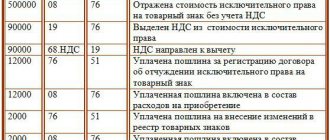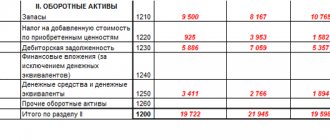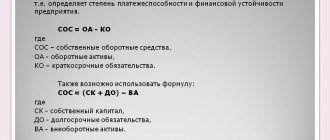Possible reasons for writing off intangible assets
As the most common reasons for writing off intangible assets, the main document dedicated to these assets (PBU 14/2007, approved by order of the Ministry of Finance of Russia dated December 27, 2007 No. 153n), names their disposal (clause 34) due to:
- expiration of the validity period of the right to the asset;
- transfer of rights to it;
- obsolescence of intangible assets;
- his contribution to the management company or mutual fund;
- transfers by exchange or gift;
- contribution to property united for joint activities;
- shortages identified during inventory.
For whatever reason, the disposal of intangible assets occurs, as of the date of this event the following must be written off from accounting (clause 34 of PBU 14/2007):
- book value of the asset;
- the amount of depreciation accrued on an asset over its useful life.
The following circumstances deserve special attention here:
- For an asset that implies mandatory registration of the right to use, recognition of disposal will occur on the date of registration of this right for the person to whom such an asset is transferred (clause 36 of PBU 14//2007, subparagraph “d”, clause 12 of PBU 9/99, approved by order of the Ministry of Finance of Russia dated 05/06/1999 No. 32n, clause 19 PBU 10/99, approved by order of the Ministry of Finance of Russia dated 05/06/1999 No. 33n).
- The difference between the values related to an intangible asset and subject to write-off upon its disposal (accounting value minus depreciation) constitutes its residual value, which may be revalued during the accounting period (clauses 16–19 of PBU 14/2007). When a revalued asset is disposed of, the amount of its revaluation, which is included in additional capital, should be removed from accounting at the same time (clause 21 of PBU 14/2007).
Read more about revaluation in the material “Revaluation of non-current assets on the balance sheet is...”.
- Depreciation for the month of asset disposal must be accrued in an amount corresponding to a full month (clause 32 of PBU 14/2007).
- An acceptance and transfer certificate signed by the head of the organization or a person authorized by him for this purpose, upon sale, exchange, donation, contribution to a management company (mutual fund) or joint activity.
- A write-off act, drawn up and signed by a commission appointed by the head of the legal entity, upon disposal at the end of the validity period, due to obsolescence or as a result of a shortage. In the latter case, the act must be preceded by an inventory list and a matching sheet, for which it is possible to use forms INV-1a and INV-18, approved by Resolution of the State Statistics Committee of the Russian Federation dated August 18, 1998 No. 88.
Documents required for write-off
To reflect the disposal of intangible assets, the following primary documents are required:
The organization develops the forms of both acts independently. A common mandatory requirement for them is to indicate the reason for disposal of the asset.
Read about the rules for completing forms INV-1a and INV-18 in the articles:
- “Unified form No. INV-1a - form and sample”;
- “Unified form No. INV-18 - form and sample.”
Accounting entries for write-offs
The financial result from the disposal of intangible assets is formed through the reflection of data related to it in other income and expenses (clause 35 of PBU 14/2007). This reflection is preceded by the formation of the residual value of the disposal asset:
Dt 05 Kt 04.
This cost is written off as expenses by posting:
Dt 91 Kt 04.
By a similar entry, expenses associated with the disposal of intangible assets will be debited to account 91 from the credit of accounts for accounting for settlements with counterparties:
Dt 91 Kt 60 (76).
If the identified shortage is the fault of a certain employee, then the following may occur:
Dt 73 Kt 04.
The resulting income from the transfer (which may occur during a sale or exchange) will be reflected by posting:
Dt 62 Kt 91.
The amount of accrued income will include VAT, the amount of which will be highlighted by posting:
Dt 91 Kt 68.
The same VAT entry will arise when donating an asset (based on the market value of this asset), despite the absence of an income accrual entry.
In relation to the revalued object, for which at the time of disposal the revaluation amount was present in the accounting records, the following entry will be made:
Dt 83 Kt 91.
Service Temporarily Unavailable
These assets are reflected in accounting at their original cost at the time of their involvement in economic (economic) turnover in accordance with their affiliation with one or another analytical account:
- 103 01 000 “Earth”;
- 103 02 000 “Subsoil resources”;
- 103 03 000 “Other non-produced assets”.
Each object of non-produced assets, regardless of whether it is in operation, in stock or on conservation, is assigned a unique serial inventory number, which is used in budget accounting registers and is not indicated on the objects (clause 29 of Instruction No. 148n).
Analytical accounting of objects of non-produced assets is maintained in the inventory card for accounting for fixed assets (f. 0504031), accounting for transactions on the disposal and transfer of objects of non-produced assets - in the journal of operations on the disposal and movement of non-financial assets (f. 0504071).
Disposal of intangible assets
The main reasons for the disposal of intangible assets listed in the organization are:
· expiration of a patent, certificate, or other documents confirming the organization’s right to use an intangible asset;
· unsuitability for further use;
· transfer to the authorized capital of other organizations;
· gratuitous transfer;
· sale of intangible assets.
In accordance with paragraph 22 of PBU 14/2000, approved by Order of the Ministry of Finance of the Russian Federation dated October 16, 2000 No. 91n “On approval of the accounting regulations “Accounting for intangible assets” PBU 14/2000 (hereinafter referred to as PBU 14/2000), the cost of intangible assets, the use of which has been discontinued for the purposes of production of products, performance of work, provision of services or for the management needs of the organization is subject to write-off.
Simultaneously with the write-off of the value of intangible assets, the amount of accumulated depreciation charges must be written off if this amount was reflected in the accounting records on account 05 “Depreciation of intangible assets.”
Income and expenses from write-off of intangible assets:
§ are subject to reflection in accounting in the reporting period to which they relate;
§ relate to the financial results of the organization.
The instructions for using the Chart of Accounts stipulate that when intangible assets are written off, their value is reduced by the amount of depreciation accrued during operation, if depreciation was taken into account on account 05 “Depreciation of intangible assets.” In accounting, this is reflected by correspondence on the credit of account 04 “Intangible assets” and the debit of account 05 “Amortization of intangible assets”. The residual value of disposed intangible assets is written off from the credit of account 04 to the debit of account 91 “Other income and expenses”, subaccount 91-2 “Other expenses”.
The balance of account 91 “Other income and expenses” is determined monthly by comparing debit and credit turnover and is written off from subaccount 91-9 to account 99 “Profits and losses”.
When accepting an intangible asset for accounting, the organization establishes its useful life. After this period, the intangible asset must be written off from accounting. The write-off of an intangible asset is carried out on the basis of an act drawn up by a specially created commission, the composition of which is determined by the head of the organization.
Based on the act of writing off an intangible asset, approved by the head of the organization, the object is written off from the register, which is recorded in the Intangible Asset Accounting Card.
Accrual of depreciation on an intangible asset in accordance with PBU 14/2000 stops from the first day of the month following the month of full repayment of the cost of the intangible asset.
Example 1.
The organization owns an intangible asset, the initial cost of which is 18,000 rubles (excluding VAT). The useful life, upon acceptance of the object for accounting, was set at 5 years and expires in December. The amount of depreciation accumulated during the operation of the intangible asset on account 05, as of November 30, is 17,700 rubles.
In December, the organization’s accountant must make the following entries:
| Account correspondence | Amount, rubles | ||
| Debit | Credit | ||
| 20,25,26 | 05 | 300 | Depreciation accrued on an intangible asset |
| 05 | 04 | 18 000 | The amount of depreciation on an intangible asset is written off |
End of the example.
Example 2.
The organization owns an intangible asset (utility model), the initial cost of which is 18,000 rubles (excluding VAT). The useful life of the asset in accordance with the patent is 5 years and this period expires in December. At the request of the patent holder, the validity period of the patent was extended by 3 years. The conditional valuation of an intangible asset object accepted by the organization is 2000 rubles.
In accordance with the adopted accounting policy, the organization charges amortization of intangible assets by reducing their original cost.
Paragraph 21 of PBU 14/2000 establishes that if depreciation charges for any intangible assets are reflected in accounting by reducing their original cost, then after full repayment of the initial cost, these objects continue to be reflected in accounting (until the expiration of the patent, certificate, other documents of protection) in a conditional valuation accepted by the organization, with the amount of the valuation attributable to the financial results of the organization.
In this example, upon expiration of the patent term (5 years), the cost of the intangible asset will be fully repaid. But since the organization has decided to extend the validity period of the patent, this intangible asset must be reflected in accounting in a conditional valuation adopted by the organization, with the valuation amount included in the financial results.
| Account correspondence | Amount, rubles | ||
| Debit | Credit | ||
| 20,25,26 | 04 | 300 | Depreciation accrued on an intangible asset in December |
| 04 | 91 | 2 000 | The intangible asset is reflected in the conditional valuation adopted by the organization |
End of the example.
In the economic activities of organizations, there are often cases when intangible assets, for various reasons, become unsuitable for further use in production or for management purposes.
The write-off of intangible assets due to their unsuitability for further use is carried out on the basis of an act drawn up by a specially created commission and approved by the head of the enterprise. The act must indicate the initial cost of the intangible asset being written off, the amount of depreciation accrued during operation, the residual value of the object, the reasons why the object is written off from accounting and other data relating to the intangible asset being written off.
The act approved by the manager is transferred to the accounting department of the enterprise, where accounting employees make a note about the disposal of the asset and make the necessary entries in the accounting accounts.
Simultaneously with the write-off of an intangible asset, the amounts of depreciation accrued during operation are written off, if it was taken into account in account 05 “Depreciation of intangible assets”.
Intangible assets, according to paragraph 1 of Article 256 of the Tax Code of the Russian Federation (hereinafter referred to as the Tax Code of the Russian Federation), are depreciable property and are used by taxpayers to generate income.
Since an intangible asset cannot be used by an organization for production purposes, it therefore cannot generate income for the organization. Consequently, such an object is subject to exclusion from depreciable property.
In accordance with paragraph 2 of Article 259 of the Tax Code of the Russian Federation, the accrual of depreciation on an object of depreciable property ceases from the 1st day of the month following the month when the cost of such an object was completely written off or when this object was removed from the depreciable property of the taxpayer for any reason.
Because an intangible asset item is derecognised before its useful life expires, part of the item's original cost remains under-depreciated. The procedure for accounting for amounts of underaccrued depreciation on intangible assets for profit tax purposes is not directly defined by the Tax Code.
However, subclause 8 of clause 1 of Article 265 of the Tax Code of the Russian Federation establishes the procedure for accounting for amounts of underaccrued depreciation on fixed assets. According to this procedure, the amount of depreciation under-accrued in accordance with the established useful life of decommissioned fixed assets is allowed to be included in non-operating expenses as reasonable costs not related to production and sales.
It would be logical to take into account the amounts of under-accrued depreciation on intangible assets written off due to unsuitability for further use, in the same order as the amounts of under-accrued depreciation on fixed assets. However, such an unambiguous conclusion cannot be made, because the procedure is provided only for fixed assets, and for intangible assets it is not, therefore, reducing the tax base for income tax on the residual value of an intangible asset is risky.
Example 3.
The organization writes off an intangible asset that is not used for production purposes. The initial cost of this asset is 21,000 rubles, the amount of depreciation accrued during operation is 16,100 rubles.
| Account correspondence | Amount, rubles | ||








